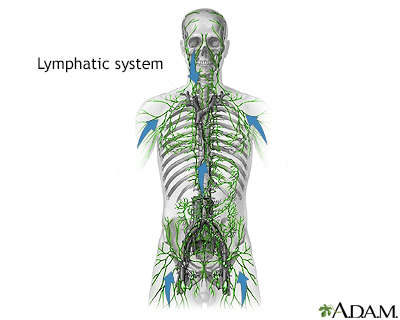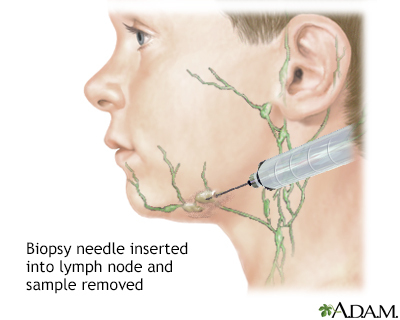Lymph node culture
Definition
Lymph node culture is a laboratory test done on a sample from a lymph node to identify germs that cause infection.
Alternative Names
Culture - lymph node
How the Test is Performed
A sample is needed from a lymph node. The sample may be taken using a needle to draw fluid (aspiration) from the lymph node or during a lymph node biopsy.
The sample is sent to a laboratory. There, it is placed in a special dish and watched to see if bacteria, fungi, or viruses grow. This process is called a culture. Sometimes, special stains are also used to identify specific cells or microorganisms before culture results are available.
If needle aspiration does not provide a good enough sample, the entire lymph node may be removed and sent for culture and other testing.
How to Prepare for the Test
Your health care provider will instruct you on how to prepare for the lymph node sampling.
How the Test will Feel
When local anesthetic is injected, you will feel a prick and a mild stinging sensation. The site will likely be sore for a few days after the test.
Why the Test is Performed
Your provider may order this test if you have swollen glands and infection is suspected.
Normal Results
A normal result means there was no growth of microorganisms on the lab dish.
Normal value ranges may vary slightly among different laboratories. Talk to your doctor about the meaning of your specific test results.
What Abnormal Results Mean
Abnormal results are a sign of a bacterial, fungal, mycobacterial, or viral infection.
Risks
Risks may include:
- Bleeding
- Infection (in rare cases, the wound may get infected and you may need to take antibiotics)
- Nerve injury if the biopsy is done on a lymph node close to nerves (the numbness usually goes away in a few months)
Gallery


References
Ferry JA. Infectious lymphadenitis. In: Kradin RL, ed. Diagnostic Pathology of Infectious Disease. 2nd ed. Philadelphia, PA: Elsevier; 2018:chap 12.
Pasternack MS. Lymphadenitis and lymphangitis. In: Bennett JE, Dolin R, Blaser MJ, eds. Mandell, Douglas, and Bennett's Principles and Practice of Infectious Diseases. 9th ed. Philadelphia, PA: Elsevier; 2020:chap 95.